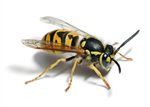Carpenter Bee
Carpenter bees build nests in wood, creating galleries that can weaken structures; however, they rarely cause severe damage. People may be frightened by carpenter bees because of their large size, their similarity to bumble bees, and their annoying noise.
IDENTIFICATION
Most carpenter bees, Xylocopa spp., are large and robust insects resembling bumble bees. They are usually about 1 inch long and colored a metallic blue-black with green or purplish reflections. They differ from bumble bees in that their abdomen is shiny with fringes of hairs on some segments. Males of some species are lighter colored, ranging into golden or buff hues.
LIFE CYCLE
Female carpenter bees bore into sound wood or sometimes into decaying wood to make nests. Nests usually consist of tunnels 1/2 inch in diameter and 6 to 10 inches deep that are partitioned into several chambers, each containing an egg and a supply of food (pollen). Carpenter bees may use old tunnels for their nests, which they sometimes enlarge; several bees may use a common entry hole connecting to different tunnels. Over a period of time, tunnels may extend as far as 10 feet into wood timbers. Tunnels are vacated after the brood’s larval and pupal stages complete their development. Development from egg to adult may take about 3 months. Carpenter bees overwinter as adults, often in old tunnels, and there is only one generation a year.
DAMAGE
Carpenter bees cause damage to wooden structures by boring into timbers and siding to prepare nests. The nests weaken structural wood and leave unsightly holes and stains on building surfaces. Sound, undecayed wood without paint or bark is usually selected for nests. Carpenter bees also frequently attack dead wood on trees or lumber from southern yellow pine, white pine, California redwood, cedar, Douglas fir, cypress, mimosa, mulberry, ash, and pecan trees. They avoid most harder woods. The presence of carpenter bees around buildings and wooden structures can be annoying or even frightening; however, males cannot sting and females rarely attack.
Umbrella Wasp
Umbrella wasps can reach 1 inch long. Umbrella wasps come in a variety of colors including yellow with black, orange, or reddish brown. They are very similar to yellowjackets. The umbrella wasp derives its name from the upside-down umbrella shape of its nest. These insects are closely related to yellowjackets, but have smaller colonies of up to several hundred workers. The nest is constructed of a paper-like substance that is a combination of chewed wood and wasp saliva. The nest hangs from a horizontal surface, supported on a single paper stalk with a single row of downward pointing cells. They are often built under eaves or inside attics. The umbrella wasp inflicts a painful sting.
DIET
Adult umbrella wasps feed on sugary liquids. They gather natural foods, such as insect larvae, to feed to their offspring.
REPRODUCTION
In early fall, the umbrella wasp colony begins to produce males and special reproductive females. These female mate with males and soon leave the nest in search of protected spots in which to spend the winter. The remaining workers eventually die and the nest becomes vacant.
OTHER INFORMATION
In the evening, workers rest on the wide, flat section of the nest. Colonies do not survive the winter, and are started by a single fertilized female.

Yellowjacket
The term “yellowjacket” refers to several different species of wasps in the genera Vespula and Dolichovespula (family Vespidae). Included in this group of ground-nesting species are the western yellowjacket, V. pensylvanica, which is the most encountered species and issometimes called the “meat bee,” and seven other species of Vespula. V. vulgaris is common in rotted tree stumps at higher elevations, and V. germanica, the German yellowjacket, is becoming more common in many urban areas of California, where it frequently nests in houses.
These wasps tend to be medium sized and black with jagged bands of bright yellow—or white in the case of the aerial-nesting D. (formerly known as V.) maculata—on the abdomen and have a very short, narrow “waist,” the area where the thorax attaches to the abdomen.
Yellowjackets commonly build nests in rodent burrows, but they sometimes select other protected cavities, such as voids in walls and ceilings of houses, as nesting sites. Colonies, which are begun each spring by a single reproductive female, can reach populations of between 1,500 and 15,000 individuals, depending on the species.
The wasps build a nest of paper made from fibers scraped from wood mixed with saliva. It is built as multiple tiers of vertical cells, like nests of paper wasps, but enclosed by a paper envelope around the outside that usually contains a single entrance hole. If the rodent hole is not spacious enough, yellowjackets will increase the size by moistening the soil and digging. Similar behavior inside a house sometimes leads to a wet patch that develops into a hole in a wall or ceiling.
Immature yellowjackets are white grublike larvae that become white pupae. The pupae develop adult coloring just before they emerge as adult wasps. Immatures normally aren’t seen unless the nest is torn open or a sudden loss of adult caretakers leads to an exodus of starving larvae.
Aerial-nesting yellowjackets, D. arenaria and D. maculata, build paper nests that they attach to the eaves of a building or that hang from the limb of a tree. The entrance normally is a hole at the bottom of the nest. These aerial nesters do not become scavengers at the end of the season, but they are extremely defensive when their nests are disturbed. Defending D. arenaria sometimes bite and sting simultaneously. Wasp stingers have no barbs and can be used repeatedly, especially when the wasp gets inside clothing. As with any stinging incident, it is best to leave the area of the nest site as quickly as possible if wasps start stinging.
